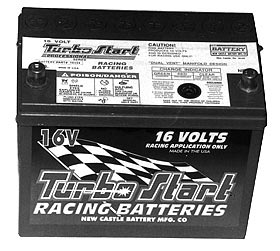
Ignition Amp Use
| RPM (V8 Powerplant) |
MSD 6 & 7 Series
|
|
3,000
|
3 |
|
4,000
|
4 |
|
5,000
|
5 |
|
6,000
|
6 |
|
7,000
|
7 |
|
8,000
|
8 |
|
9,000
|
9 |
|
10,000
|
10 |
|
11,000
|
11 |
|
12,000
|
12 |
The following is a sample racecar Ah draw.
As you can see, it's a pretty simple car. In
the example, pretend the engine sees a maximum
RPM ceiling of 8,000 RPM.
- Electric fuel pump: 8 amps
- Electric water pump drive: 5 amps
- Other accessories: 5 amps
- Ignition requirements: 8 amps
Total: 26 amps
Multiply the total electrical requirements
by the duration of time it must operate without
a battery recharge. This is particularly important
for racecars without charging systems. Keep
in mind that we're not talking about seven to
ten seconds in this case. Consider the time
you "hurry up and wait" in the staging lanes,
the time to make a burnout, time to stage, driving
down the return road and so on. In this case,
a safe figure is 1/2 hour maximum. Multiply
the amp requirement by the time:
26 amps X 1/2 hour = 13 amps
Now, the final step in the equation (and one
which might surprise you): Starting the car.
To determine just how many amps it requires
to start the car, multiply the final amp requirement
figure by a factor of 3:
13 amps X 3 = 39 amps
The final 39-amp number is the size of battery
required for your application. Using the very
first equation that showed how to convert RC
(reserved capacity) to Ah, you can then go battery
shopping.
What Batteries Are Right?
There are a number of batteries that work in
drag race applications. The trouble is, once
you get deeper into the rounds of competition,
the time between rounds obviously decreases.
That's precisely where the advantage of a 16-volt
system enters the equation.
 16-volt
batteries are more common in drag racing than
you might think. A typical lead/acid battery
produces a maximum of 2.1 volts per cell open
circuit or 12.6 volts total. As soon as a load
is placed on a 12-volt battery, the voltage
per cell will rapidly drop to 2.0 volts per
cell or 12 volts total. Operating below this
voltage level can cause ignition problems such
as a high- speed miss. Reduced voltage will
also negatively affect the starter along with
the ability to spin the engine. 16-volt
batteries are more common in drag racing than
you might think. A typical lead/acid battery
produces a maximum of 2.1 volts per cell open
circuit or 12.6 volts total. As soon as a load
is placed on a 12-volt battery, the voltage
per cell will rapidly drop to 2.0 volts per
cell or 12 volts total. Operating below this
voltage level can cause ignition problems such
as a high- speed miss. Reduced voltage will
also negatively affect the starter along with
the ability to spin the engine.
Typical racing ignition systems in use today
require at least 12 volts to produce an optimum
spark. A lead/acid battery cell (flooded cell,
gel-cell, or starved electrolyte) produces a
maximum of 2.1 volts per cell open circuit or
12.6 volts total. As soon as a load is placed
on a 12-volt battery, the voltage per cell will
drop to 2.0 volts per cell or 12 volts total.
Operating below this level often results in
ignition problems such as a high speed miss.
Reduced voltage will also negatively affect
the starter and it's ability to spin the motor.

|